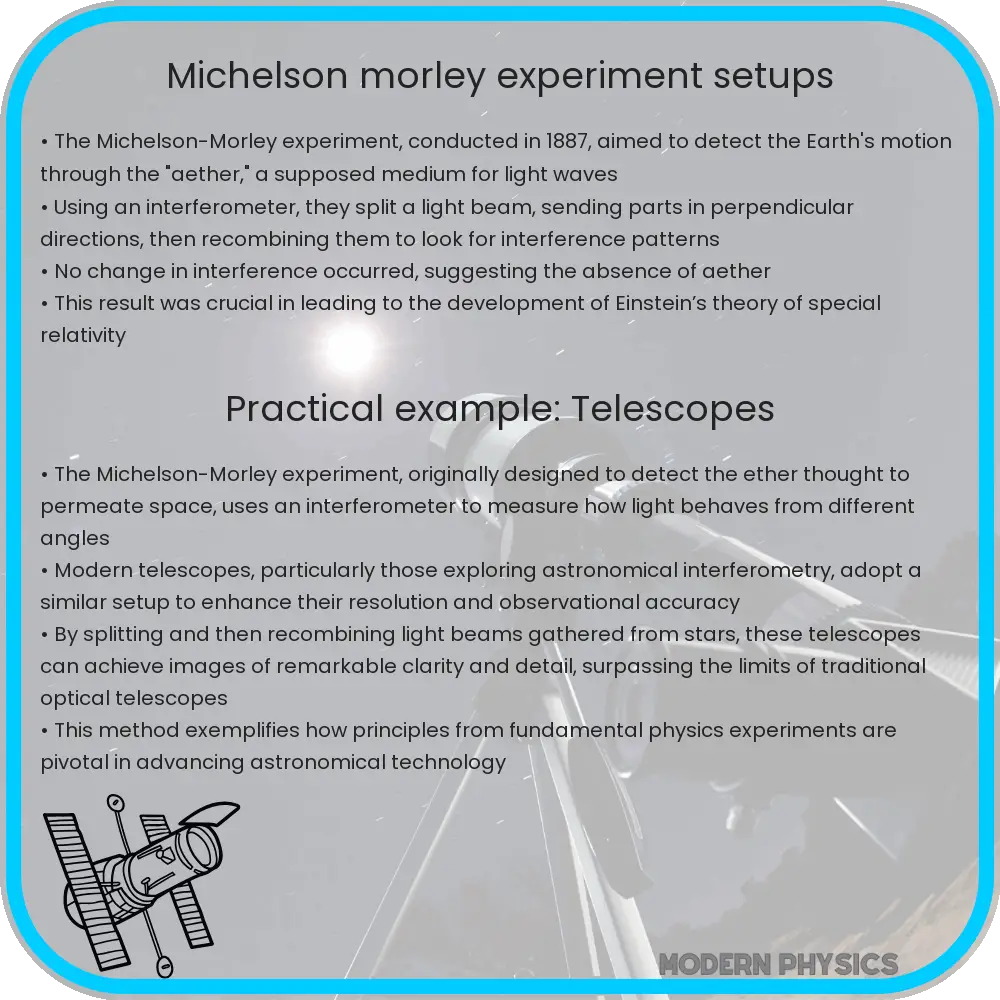Explore the Michelson-Morley Experiment’s role in disproving aether theory, paving the way for Einstein’s relativity and modern physics.

Understanding the Michelson-Morley Experiment: The Pinnacle of Precision and its Role in Relativity
The Michelson-Morley Experiment, conducted in 1887, stands as a pivotal moment in the annals of physics. Devised by American scientists Albert A. Michelson and Edward W. Morley, this experiment sought to detect the presence of ‘aether’, a hypothetical medium believed to permeate space and serve as a carrier for light waves. The profound implications of their findings inadvertently set the stage for the advent of Einstein’s theory of relativity, reshaping our understanding of physics.
Objective and Methodology
Michelson and Morley aimed to measure the speed of light in different directions to detect the relative motion of Earth through the aether. They used an apparatus called the Michelson interferometer, which split a beam of light into two perpendicular paths. After reflecting off mirrors, these beams were recombined to create an interference pattern. The expectation was that movement through the aether would cause a shift in this pattern, akin to a swimmer moving against or with the current.
Unexpected Results and Implications
Contrary to expectations, the experiment revealed no significant difference in the speed of light in any direction. This null result was baffling, as it suggested either the absence of aether or that Earth’s motion had no effect on the speed of light. This outcome directly conflicted with the classical wave theory of light, which postulated that light, like sound, required a medium for propagation.
Impact on the Foundations of Physics
The Michelson-Morley experiment’s inability to detect aether had far-reaching consequences. It challenged existing notions of absolute space and time, paving the way for Albert Einstein’s Special Theory of Relativity. Einstein postulated that the speed of light is constant in all inertial frames of reference, a revolutionary idea that dismissed the need for aether. This theory fundamentally altered our understanding of space, time, and motion, marking a paradigm shift in physics.
The experiment’s precision and methodology were also groundbreaking. Michelson’s development of the interferometer, an instrument capable of measuring minute differences in the speed of light, demonstrated an unprecedented level of experimental precision. This tool has since become integral in various scientific fields, illustrating the lasting impact of their methodological innovation.
In conclusion, the Michelson-Morley experiment, despite—or perhaps because of—its null result, stands as a cornerstone in the evolution of modern physics. Its implications stretched far beyond the immediate scope of the experiment, fostering a new era of theoretical and experimental physics.
The Legacy of the Michelson-Morley Experiment in Modern Science
The Michelson-Morley experiment’s influence extends beyond its immediate role in debunking the aether theory. It symbolizes a critical juncture in scientific thought, where empirical evidence began to override established theories. The experiment’s null result, initially seen as a failure, actually provided a crucial empirical basis for Einstein’s theories and the development of modern physics.
Revolutionizing Physics: The Birth of Relativity
Einstein’s Special Theory of Relativity, formulated in 1905, was deeply influenced by the findings of the Michelson-Morley experiment. By asserting that the speed of light is constant and independent of the observer’s motion, Einstein negated the need for an aether. This led to groundbreaking concepts like time dilation and length contraction, reshaping our understanding of space and time. The Michelson-Morley experiment thus indirectly laid the groundwork for these revolutionary ideas.
Technological Advancements and Applications
The interferometer, a byproduct of this experiment, has had a profound impact on science and technology. Its precision and versatility have been essential in various fields, from astronomy to communication technologies. For instance, interferometers are critical in gravitational wave detection, a major scientific breakthrough of the 21st century. Additionally, this technology has applications in fiber-optic communication systems, enhancing the efficiency and speed of data transmission globally.
Philosophical and Educational Impact
On a philosophical level, the Michelson-Morley experiment underscores the importance of empirical evidence in science. It serves as a powerful reminder that scientific progress often involves challenging and revising established beliefs. Educationally, it is frequently used as a case study in scientific methodology, demonstrating the value of precise measurement and the interpretation of null results.
Conclusion
In summation, the Michelson-Morley experiment, a landmark event in the history of physics, has had a lasting impact on both the theoretical and practical aspects of science. Its implications were instrumental in the shift from classical to modern physics, particularly in the development of the theory of relativity. The experiment’s legacy is evident in various technological advancements and continues to inspire scientific inquiry and philosophical thought. As a testament to the enduring power of curiosity and rigorous scientific investigation, the Michelson-Morley experiment remains a pivotal reference point in our quest to understand the fundamental principles of the universe.
Is this conversation helpful so far?
